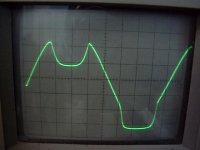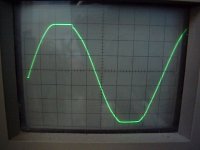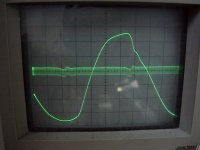> Wouldn´t the cap sort of compromise the CS function (as do the McMillans) in that it´s possible to have more current through the diff pair than the 10mA?
I presume you are referring to the 22uF cap I proposed.
If you were not using source degeneration, AND you have a balanced input, the source voltage (relative to ground) should stay pretty much constant even at full swing, so that the 22uF cap is not really charging or discharging from the CS. It is sort of restricted by the 3rd resistor, the value of which you have to experiment with.
The problem with the McMillan is that if you have common mode at the output (which I suspect), you get that 1:1 through the McMillans durectly into the diff pair.
It is more a voltage thing than a current thing. If you get what I mean.
Patrick
PS I take back my comment some time earlier that your source resistors make no difference. They do make a difference in common mode.
I presume you are referring to the 22uF cap I proposed.
If you were not using source degeneration, AND you have a balanced input, the source voltage (relative to ground) should stay pretty much constant even at full swing, so that the 22uF cap is not really charging or discharging from the CS. It is sort of restricted by the 3rd resistor, the value of which you have to experiment with.
The problem with the McMillan is that if you have common mode at the output (which I suspect), you get that 1:1 through the McMillans durectly into the diff pair.
It is more a voltage thing than a current thing. If you get what I mean.
Patrick
PS I take back my comment some time earlier that your source resistors make no difference. They do make a difference in common mode.
OK,
just one other thing cause I don´t know if I made that clear the last time.
I measure 0,15V at the sources (p-p) when there´s around 22x2x1.4= 60V at the output (p-p)
This is 0,25% (made a mistake last time)
This voltage fed through the McMillans is dependent on the value of the McMillans isn´t it?
If these resistors are 0,25% off (wich is possible with 1% MF) then you would also see a voltage at the sources wouldn´t you? Even if there´s no common mode distortion at all?
William
just one other thing cause I don´t know if I made that clear the last time.
I measure 0,15V at the sources (p-p) when there´s around 22x2x1.4= 60V at the output (p-p)
This is 0,25% (made a mistake last time)
This voltage fed through the McMillans is dependent on the value of the McMillans isn´t it?
If these resistors are 0,25% off (wich is possible with 1% MF) then you would also see a voltage at the sources wouldn´t you? Even if there´s no common mode distortion at all?
William
> If these resistors are 0,25% off (wich is possible with 1% MF) then you would also see a voltage at the sources wouldn´t you? Even if there´s no common mode distortion at all?
The answer is yes.
But then before we reject the common mode hypothesis, how do you explain the fact that this "distortion" you observed would disappear if you disconnect the McMillan resistors altogether ?
My proposal to add a thrid resistor and a cap is a sort of passive DC servo, if you like.
Patrick
The answer is yes.
But then before we reject the common mode hypothesis, how do you explain the fact that this "distortion" you observed would disappear if you disconnect the McMillan resistors altogether ?
My proposal to add a thrid resistor and a cap is a sort of passive DC servo, if you like.
Patrick
> I don´t know if it would disappear cause my amp is not DC stable without them (I tried)
If you meant that you have a DC drift over hours or minutes, then you can still do a quick test without them.
If you meant you have common mode oscillations with time period below 1 minute, then it certainly means that you have some more problems to solve, because the circuit should work without the Mcmillans.
Try removing them and loading the 2 outputs with say 33R 10W to ground (respectively).
Patrick
If you meant that you have a DC drift over hours or minutes, then you can still do a quick test without them.
If you meant you have common mode oscillations with time period below 1 minute, then it certainly means that you have some more problems to solve, because the circuit should work without the Mcmillans.
Try removing them and loading the 2 outputs with say 33R 10W to ground (respectively).
Patrick
Taking the McMillans out did it for Xavier.
So it only remains my 3rd resistor + cap solution to try out ?
A servo is a bit more complicated, I think. And you should really do the servo by changing the reference voltage of the diff pair CCS so that it is sort of less invasive than adding current at the diff pair source directly.
Patrick
So it only remains my 3rd resistor + cap solution to try out ?
A servo is a bit more complicated, I think. And you should really do the servo by changing the reference voltage of the diff pair CCS so that it is sort of less invasive than adding current at the diff pair source directly.
Patrick
Hi,
I will try the third resistor plus cap.
A DC-servo is more or less ready but not tested yet (and if possible I would like to avoid it)
Without the McMillans is not possible for me as the startup dc-offset will be way too high.
Xavier,
how does it sound without the McMillans?
Hugo,
did some tests yet?
William
I will try the third resistor plus cap.
A DC-servo is more or less ready but not tested yet (and if possible I would like to avoid it)
Without the McMillans is not possible for me as the startup dc-offset will be way too high.
Xavier,
how does it sound without the McMillans?
Hugo,
did some tests yet?
William
Originally posted by sinuko
have you remove the caps between C-B of q3-q8 ?
Which resistor do you use for R1-R4 and R44-R45? At the moment
I just removed the McMillans, leaving everything the same. The resistor to ground I use is 68R. The absolute offset starts at about +15v and after a while goes downto -1v aprox.
Although there is been much improvement, the behavior is still there, but starting after 30vpk.
The next thing I will try is to reduce the resistor to gnd to be able to reduce the offset and try to remove the caps between C-B of q3 and q8.
Xavier
I used a variac and tried a few voltages between 20 and 30V.
I can’t reproduce the clipping like you showed in post #46 but noticed two things.
The first being a sagging of the waveform (at peak level) which is IMO due to current starving and a second being clipping (flat tops) which is just the sine wave bouncing at the rails.
In all cases this can be cured by either upping the bias and/or the voltage and the limit is determined by the heat sink capacity, long before the mosfets leave the SOA.
With lower rails, we have the luxury of more bias and I believe my amp hits the sweetest spot at about 24V, voltage and current wise.
The diff pair current source is build around a TL431 and when changing the rail voltage, I first trim both relative and absolute offset which surprisingly adjust very well together.
Then, I make the amp clip just a little bit and adjust the bias of both halves until I get a little flat line on both the upper and lower part of the sine wave. All measurements have been done with a dummy load.
All in all, I don’t think I presented something new.
First picture is what I call the current starving mode:
I can’t reproduce the clipping like you showed in post #46 but noticed two things.
The first being a sagging of the waveform (at peak level) which is IMO due to current starving and a second being clipping (flat tops) which is just the sine wave bouncing at the rails.
In all cases this can be cured by either upping the bias and/or the voltage and the limit is determined by the heat sink capacity, long before the mosfets leave the SOA.
With lower rails, we have the luxury of more bias and I believe my amp hits the sweetest spot at about 24V, voltage and current wise.
The diff pair current source is build around a TL431 and when changing the rail voltage, I first trim both relative and absolute offset which surprisingly adjust very well together.
Then, I make the amp clip just a little bit and adjust the bias of both halves until I get a little flat line on both the upper and lower part of the sine wave. All measurements have been done with a dummy load.
All in all, I don’t think I presented something new.
First picture is what I call the current starving mode:
Attachments
- Status
- This old topic is closed. If you want to reopen this topic, contact a moderator using the "Report Post" button.
- Home
- Amplifiers
- Pass Labs
- AlephJ-X


